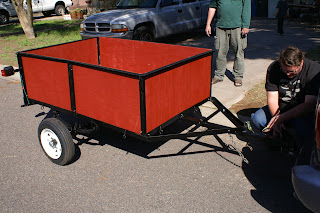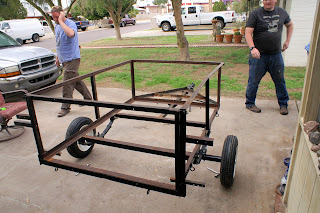So a while back I purchased from ebay a radio similar to this:
for parts not working.
Well I got it working but the clock would not keep time, the plastic case was ugly, and I do not like clock radios anyways.
I pulled the guts and gave it a newer better speaker.
Well I got it working but the clock would not keep time, the plastic case was ugly, and I do not like clock radios anyways.
I pulled the guts and gave it a newer better speaker.
I decided to put it in a new cabinet. However it is 108 here and I
had no interest in trying to build a cabinet in the heat. I went to
Micheal's and picked up a small non square box to put it in for $5.00.
I then removed the lid and hinges, and glued in some supports for the components and for the back.
I drilled holes in it for the tuning knob and volume.
I temporarily mounted the board in the radio sideways like it was in the
original. I will be drilling 1 or more holes in the bottom of the
cabinet later to get some air flowing over the tubes.
I made a cutout of the speaker so that I could place it correctly. The
tuning dial and volume knob are from the old radio and will probably not
be going on the new cabinet. I found that I needed to move the speaker
over about 3/8" from my initial placement. The speaker hole will be cut
out and some cloth I picked up will go over the speaker, then I will
make a decorative flange to go over the speaker and cover up the speaker
hole.
I had purchased some large beads for the feet and attached them.
I went looking for a prefabbed cutout for the speaker and could not find
anything, both at craft stores and on line. I will have to keep looking
as I do not have the proper tools to make what I want. I did cut out a
hole in the bottom and found a small chrome fan grill to keep probing
fingers out.
I also gave the wood I nice stain. However that uncovered a flaw on the
bottom of the craft box. It has scratches at right angle to the grain. I
had sanded the face (with the grain) but did not see it till it was
stained. Oh well it gives it character.
I have the following completed. I have figured out where to wire the
pilot light. Installed the mp3 input on the board, and put on a thin
coat of spray varnish. Now she needs to dry overnight. When I put the
feet on this time it sits perfectly without rocking.
























































